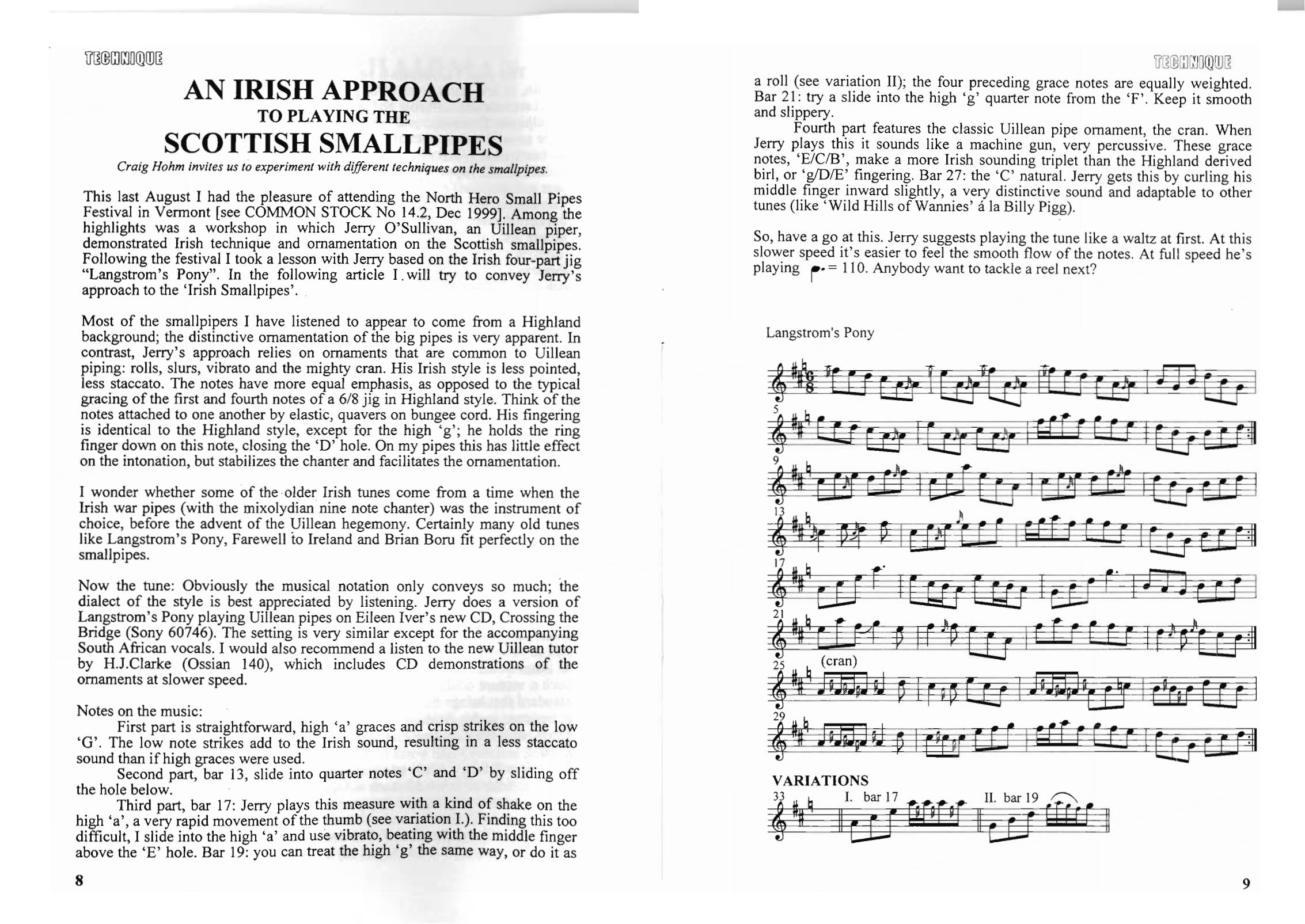An Irish Approach to Playing the Scottish Smallpipes

Craig Hohm invites us to experiment with different techniques on the smallpipes.
This last August I had the pleasure of attending the North Hero Small Pipes Festival in Ver- mont [see COMMON STOCK No 14.2, Dec 1999]. Among the highlights was a workshop in which Jerry O’Sullivan, an Uillean piper, demonstrated Irish technique and ornamenta- tion on the Scottish smallpipes. Following the festival I took a lesson with Jerry based on the Irish four-part jig “Langstrom’s Pony”. In the following article I will try to convey Jerry’s approach to the ‘Irish Smallpipes’.
Most of the smallpipers I have listened to appear to come from a Highland background; the distinctive ornamentation of the big pipes is very apparent. In contrast, Jerry’s approach re- lies on ornaments that are common to Uillean piping: rolls, slurs, vibrato and the mighty cran. His Irish style is less pointed, less staccato. The notes have more equal emphasis, as opposed to the typical gracing of the first and fourth notes of a 6/8 jig in Highland style. Think of the notes attached to one another by elastic, quavers on bungee cord. His finger- ing is identical to the Highland style, except for the high ‘g’; he holds the ring finger down on this note, closing the ‘D’ hole. On my pipes this has little effecton the intonation, but stabilizes the chanter and facilitates the ornamentation.
I wonder whether some of the older Irish tunes come from a time when the Irish war pipes (with the mixolydian nine note chanter) was the instrument of choice, before the ad- vent of the Uillean hegemony. Certainly many old tunes like Langstrom’s Pony, Farewell to Ireland and Brian Boru fit perfectly on the smallpipes.
Now the tune: Obviously the musical notation only conveys so much; the dialect of the style is best appreciated by listening. Jerry does a version of Langstrom’s Pony playing Uil- lean pipes on Eileen Iver’s new CD, Crossing the Bridge (Sony 60746). The setting is very similar except for the accompanying South African vocals. I would also recommend a lis- ten to the new Uillean tutor by H.J. Clarke (Ossian 140), which includes CD demonstra- tions of the ornaments at slower speed.
Notes on the music:
First part is straightforward, high ‘a’ graces and crisp strikes on the low ‘G’. The low note strikes add to the Irish sound, resulting in a less staccato sound than if high graces were used.
Second part, bar 13, slide into quarter notes ‘C’ and ‘D’ by sliding off the hole below.
Third part, bar 17: Jerry plays this measure with a kind of shake on the high ‘a’, a very rapid movement of the thumb (see variation I.). Finding this too difficult, I slide into the high ‘a’ and use vibrato, beating with the middle finger above the ‘E’ hole. Bar 19: you can treat the
same way, or do it as a roll (see variation II); the four preceding grace notes are equally weighted. Bar 21: try a slide into the high ‘g’ quarter note from the ‘F’. Keep it smooth and slippery.
Fourth part features the classic Uillean pipe ornament, the cran. When Jerry plays this it sounds like a machine gun, very percussive. These grace notes, ‘E/C/B’, make a more Irish sounding triplet than the Highland derived birl, or ‘g/D/E’ fingering. Bar 27: the ‘C’ natural. Jerry gets this by curling his middle finger inward slightly, a very distinctive sound and adaptable to other tunes (like ‘Wild Hills of Wannies’ a la Billy Pigg).
So, have a go at this. Jerry suggests playing the tune like a waltz at first. At this slower speed it’s easier to feel the smooth flow of the notes. At full speed he’s playing = 110. Any- body want to tackle a reel next?
